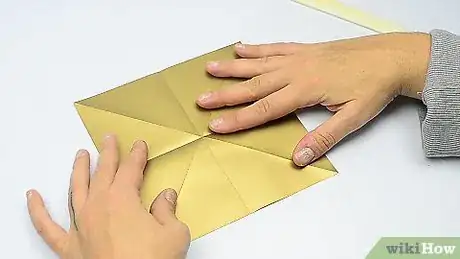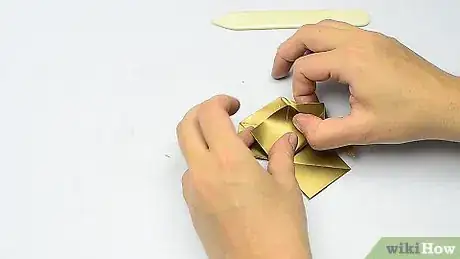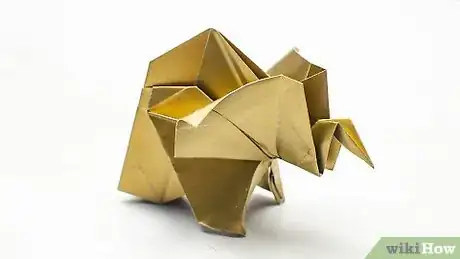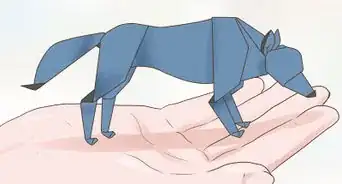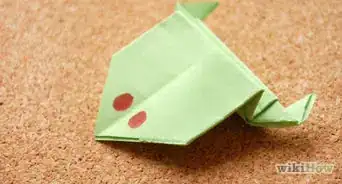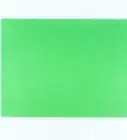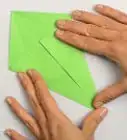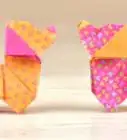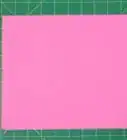This article was co-authored by wikiHow Staff. Our trained team of editors and researchers validate articles for accuracy and comprehensiveness. wikiHow's Content Management Team carefully monitors the work from our editorial staff to ensure that each article is backed by trusted research and meets our high quality standards.
There are 35 references cited in this article, which can be found at the bottom of the page.
The wikiHow Video Team also followed the article's instructions and verified that they work.
This article has been viewed 77,442 times.
Learn more...
Making an elephant is a fun project for anyone experienced in the ways of origami. Starting with a square piece of origami paper, you fold the paper to create guidelines. The guidelines are creases that help you line up the series of folds needed to shape the paper into an elephant. Afterward, you can give your elephant details like feet and a trunk with a few additional folds.
Steps
Creating the Guidelines
-
1Fold the paper in half, then open it up and fold it in half the other way. Orient a square piece of origami paper so a corner points towards you. Fold the bottom corner up to the top corner and flatten it. Then, unfold it and repeat the fold with the remaining corners.[1]
- If your paper has a white side and a colored side, place the white side face down. It will help you keep track of the folds you need to make.
- Bigger pieces of paper are easier to work with. Try using an oversized sheet of origami paper for your first elephant.
-
2Bring the bottom corner to the center of the paper. Make sure the paper is completely unfolded. After making the fold, flatten the paper. Rotate the sheet 90 degrees so the folded edge is on the right.[2]
- Leave the paper folded after rotating it.
Advertisement -
3Pinch the top corner towards the right edge. Bring the top corner over to the right edge of the paper. Rest the corner about ⅔ of the way up the fold. Make sure the edges of the paper are aligned. Then, along the center of the paper, pinch the new fold lightly to leave a little mark. Open the paper all the way back up when you’re done.[3]
- Avoid creasing the paper while you make this fold.
-
4Bring the lower corner to the pinch mark, then fold the remaining corners. Fold the corner up, then crease the paper completely. Unfold the paper again when you’re done. Finish by folding the remaining corners at the same time, pressing them flat to make full creases, before opening the paper back up again.[4]
- If you did all the folds correctly, you will see a square in the center of the paper. The bottom part of the square will have 2 fold lines. The diagonal pinch mark will be below the square’s upper edge.
-
5Move the top and bottom corners in to create small marks. Move the corner up to the second horizontal crease at the bottom of the square. Pinch the center to leave a little mark, then unfold the paper. Next, bring the opposite corner down to the pinch mark, then make another pinch mark in the center. Unfold the paper when you’re done.[5]
- Avoid creasing the paper when performing these folds. When you’re done, the paper will have a little mark near its center.
-
6Move the top corner down to the paper’s center. Bring the corner down to the pinch mark. Flatten the fold out to crease the page. Unfold it again when you’re done.
-
7Fold the left and right corners to the creases on the opposite side. Start with the right corner. Bring it towards the left corner, aligning it with the left edge of the square formed by the creases. Flatten the crease, unfold the paper, and then repeat the fold with the left corner.[6]
- Make sure both sides of the paper look identical. The creases are guidelines for the next folds. After finishing them, you can begin folding the paper into the shape of an elephant.
Making the Initial Folds
-
1Reverse the bottom crease and fold it up. Work with the bottom of the 2 creases near the corner closest to you. Lift the paper up and fold it down along that crease to form a little ridge. Then, push the fold up and back over the paper. Fold the paper along the second crease until the ridge is against the paper and you can flatten the crease.[7]
- This fold is called a mountain fold. The 2 creases were made with valley folds. Valley folds fold inwards, forming valleys, while mountain folds are the opposite.
-
2Refold the upper corner with a mountain fold. You will need to repeat the fold you did with the bottom corner. Fold the lower of the 2 creases up to form a ridge. Then, fold the ridge over onto the paper by using the higher crease.[8]
- Make sure you reverse the fold in the lower crease for both corners, not the higher one.
-
3Fold the top corner down and up again. Bring the corner straight down, folding it over the ridge from your last fold. Then, grab the tip of the corner. Fold the exposed edge to the right of the corner about halfway up the triangle. Finish this part by undoing the last fold and repeating it with the edge to the left of the corner.[9]
- Use the crease on the right as a guideline when folding the corner tip back up. The second fold needs to be perpendicular to it.
- Make sure the second fold looks horizontal and parallel to the upper edge of the page when you’re done.
-
4Create a rabbit ear fold by pinching the paper’s edges together. Undo the last fold you did. Pick up the top corner of the paper, folding it up about halfway. By pinching the sides at the creases from the earlier folds, the corner will form a point. Pinch the point together so it retains its shape, then fold it to the left to flatten it.[10]
- The rabbit ear will rise up off the page until you flatten it.
-
5Pick up the paper and fold it along the center. Reverse the center crease into a mountain fold. After lifting the paper, fold it along the vertical center crease. It will leave you with a left and right side. Set the paper down on the table again and rotate it so the small, triangular flap points up.[11]
- When this part is done correctly, the small, triangular flap will be on the right side of the paper. A larger, folded triangle will be on the left side.
-
6Open the right edge up, bring it to the center, and collapse it. Stick your finger between the surfaces on the right side of the page. Carefully bring the edge up until it is over the vertical centerline. Then, push down on the ridge of paper to flatten it.[12]
- Make sure the paper collapses evenly. You will need to open it up with your finger as much as possible. The collapsed parts to the left and right of the centerline need to look identical.
-
7Fold the left flap over to the right corner. Grasp the left corner of the part you collapsed in the last step. Bring it over, then smooth the crease. Check the edges to make sure they align.[13]
- Use your finger to push in the paper as you fold it. This will help you achieve a smooth, even crease.
- If you did everything correctly, the front and back sides of the paper will now look even.
-
8Move the bottom edge up, then fold its right flap over. Locate the horizontal crease near the upper edge. Grasp the bottom edge of the paper, leaving behind the half of paper underneath it. Fold it up along the crease line but don’t flatten it yet. Instead, fold it down and to the left.[14]
- When this fold is done correctly, the paper flap will form a sort of tube. It will align with the diagonal edge of the paper beneath it.
- As you move the bottom edge up, you will see a small flap in the center of the page. Press it down so you can fold the paper to the left evenly.
-
9Fold the top flap of paper down along the bottom crease. Look for the crease near the bottom of the section you just folded. Fold the top flap along this line and smooth it out to finish this part.[15]
-
10Turn the paper over and repeat the last 2 steps. Make the same series of folds to keep both sides even. Look for the crease closest to the top edge, then bring the bottom flap of paper up. Open it up before folding it to the right. Finish by folding the top flap down along the lower crease.[16]
- Use your finger to push in the interior parts of the paper, ensuring you get quality folds.
Forming the Elephant's Shape
-
1Fold the larger flap over and open it up. The elephant will look like a rectangle with a small flap on 1 side and a large flap on the other. Orient it so the large flap is on the right. Pick up the flap and fold it over onto the rectangle. Then, open it back up and pick up the paper. Put your finger inside the flap to stand it up and open it. Finally, push down on it to collapse it over the edge of the rectangle.[17]
- You will notice a piece of paper inside the flap. Place your finger over that piece so you can reach the center of the flap.
- The tip of the flap will align with the right edge of the rectangle after you flatten it.
-
2Bring the left side of the flap over to the right corner. Make sure you are folding the left edge of the part you collapsed in the last step. Fold it in half so the edges align with one another.[18]
-
3Fold the paper in half from the bottom up. Put your finger underneath the flap over the center rectangle of paper. Then, bring the bottom edge up towards the top edge. Keep your finger in place, pulling the flap out to the right. Gently flatten the right flap so it matches the edge underneath it.[19]
- Make sure the flap of paper doesn’t get tucked inside the fold. It needs to be on the outside.
-
4Open the top edge of the paper and flatten it. The top half of the paper will look like a square now. Grasp the top flap only, stand it up, and push your finger into it to open it. Align the corner over the bottom edge of the square and press it flat.[20]
-
5Turn the paper over and repeat the folds. When you turn the paper over, you will see a longer flap on the left and smaller flaps on the right. Start by holding the left flap up, then fold the bottom part of the paper up to the top. Insert your finger in the top flap, stand it up, and collapse it over the center of the square.[21]
- The finished fold will leave a triangle on the left that will form the trunk and a flap on the right for the back end of the elephant.
-
6Fold the bottom flap up to the top edge of the paper. Turn the page slightly so the bottom edge of the paper is horizontal with the triangular flaps for the trunk on the left. Grasp the uppermost flap over the bottom edge. Fold it up, aligning it with the top edge.[22]
- The corner on the bottom edge will align with the corner on the top edge. The paper will look symmetrical if you did everything correctly.
-
7Curl the top flap down to the center of the paper. On the right side of the paper, you will see a diamond with 2 perpendicular creases running through its center. Put your right thumb in the center, then grasp the edge of the paper above it with your other hand. Pull it down, folding the flap in over itself. Then, pull the flap down towards the bottom edge of the paper.[23]
- When this part is done correctly, the flap will point down past the bottom edge of the page. It will have a horizontal crease near its center.
- This part can be tricky. Take your time and make sure the folds are good before moving on.
-
8Pull the top flap up to release the paper. Look for a point on the left side of the top edge of the elephant. Pulling it enables you to see the folds there. You will see a ridge from a mountain fold and a valley from a valley fold.[24]
- Hold the rest of the paper with your other hand to keep it in place as you pull the flap.
-
9Reverse the folds on the flap. Carefully flatten out the paper around the folds. Push the ridge down and fold the paper, then unfold it and do the opposite to the valley fold crease. Smooth the paper out again.[25]
- The top edge of the paper will be flat when you’re finished.
-
10Repeat the folds on the back side of the paper. Turn the paper over, then bring the bottom edge up to fold the paper along the horizontal centerline. Fold the top edge over to the center point and down. Then, open up the flap near the elephant’s ear and reverse the mountain and valley folds.[26]
- A good elephant looks symmetrical on both sides. Make sure the leg flaps, which are the big ones pointing downwards, are stacked on top of one another.
-
11Tuck the inner folds in to form the elephant’s back. Orient the page so the long piece for the trunk is on the left. On the top edge of the paper, you will see a ridge with 2 smaller flaps next to it. Grasp the flap, then fold it down until its bottom edge is aligned with the nearby ear flap. Then, open the fold, reversing it.[27]
- Flip the elephant over and repeat the fold with the flap on the other side.
Creating the Legs
-
1Fold the points on the legs up, then unfold them. The triangular flaps underneath the elephant’s head form the front leg. Grasp 1 of the leg flaps, then fold it so the crease aligns with the bottom edge of the elephant’s back legs. Unfold it when you’re finished.[28]
- Turn the elephant over and repeat this with the other leg.
-
2Open up the leg flaps and reverse the folds. Grab 1 of the flaps, then stick your finger in it to open it. Push the tip down to form a valley. Repeat this with the other leg.[29]
- Flatten the paper after you collapse it to get good creases on the legs.
-
3Repeat the folds on the elephant’s back legs. The 2 points on the elephant’s back end are the legs. Fold them back and forth to crease them. Then, open them up to collapse and reverse them.[30]
-
4Open the elephant’s back edge and fold the flaps to the side. Pull open the back to separate it into 2 flaps. Each flap will have a diagonal portion and flat portion. Fold the flat portion in to the center, then fold the flap over again. Repeat this with the other side to finish the back legs.[31]
- You will be folding several layers of paper at this point. Go slowly to get clean folds.
Adding Additional Details
-
1Fold the trunk up, then fold the tip. Grasp the tip of the trunk and locate the bottom edge of the ear flaps. Make the trunk crease level with that edge. Unfold the trunk, then spread the flaps forming the elephant’s head. Push the trunk in and fold it in the opposite direction of the initial fold.[32]
-
2Repeat the folds with the tip of the trunk. Fold the tip down slightly, then unfold it. Use your finger to spread the flaps in the trunk. Then, collapse the tip to reverse the fold. Finish the trunk by pulling the tip down slightly.[33]
- Folding the trunk multiple times gives it additional wrinkles that make it look more detailed.
-
3Fold the front corners on the elephant’s head. Spread the flaps apart and work on 1 side at a time. Curl the tip over and press the fold flat. Repeat this with the other flap.[34]
- This will round the front part so the elephant’s head doesn’t look too square.
-
4Tuck in the inside flap to make the elephant stand. Use your finger to create space inside the elephant’s center. Grab the small flap on the elephant’s back end. Hold onto the tail as you fold the flap up and inside.[35]
- If your paper has a white back, the flap will be white and easy to spot.
- After you do this, your elephant will be able to stand on its own.
Things You’ll Need
- Table
- Origami paper
- Folding bone (optional)
References
- ↑ https://www.youtube.com/watch?v=ElCl48phJ4Y&feature=youtu.be&t=26
- ↑ https://www.youtube.com/watch?v=KVLmVMR8m0Y&feature=youtu.be&t=71
- ↑ https://www.youtube.com/watch?v=InIpbaPdA54&feature=youtu.be&t=78
- ↑ https://www.youtube.com/watch?v=zgyMARIDFSA&feature=youtu.be&t=7
- ↑ https://www.youtube.com/watch?v=InIpbaPdA54&feature=youtu.be&t=158
- ↑ https://www.youtube.com/watch?v=ElCl48phJ4Y&feature=youtu.be&t=179
- ↑ https://www.youtube.com/watch?v=zgyMARIDFSA&feature=youtu.be&t=28
- ↑ https://www.youtube.com/watch?v=KVLmVMR8m0Y&feature=youtu.be&t=294
- ↑ https://www.youtube.com/watch?v=KVLmVMR8m0Y&feature=youtu.be&t=309
- ↑ https://www.youtube.com/watch?v=InIpbaPdA54&feature=youtu.be&t=371
- ↑ https://www.youtube.com/watch?v=ElCl48phJ4Y&feature=youtu.be&t=369
- ↑ https://www.youtube.com/watch?v=InIpbaPdA54&feature=youtu.be&t=428
- ↑ https://www.youtube.com/watch?v=zgyMARIDFSA&feature=youtu.be&t=40
- ↑ https://www.youtube.com/watch?v=KVLmVMR8m0Y&feature=youtu.be&t=461
- ↑ https://www.youtube.com/watch?v=KVLmVMR8m0Y&feature=youtu.be&t=510
- ↑ https://www.youtube.com/watch?v=InIpbaPdA54&feature=youtu.be&t=530
- ↑ https://www.youtube.com/watch?v=zgyMARIDFSA&feature=youtu.be&t=49
- ↑ https://www.youtube.com/watch?v=ElCl48phJ4Y&feature=youtu.be&t=534
- ↑ https://www.youtube.com/watch?v=ElCl48phJ4Y&feature=youtu.be&t=547
- ↑ https://www.youtube.com/watch?v=KVLmVMR8m0Y&feature=youtu.be&t=672
- ↑ https://www.youtube.com/watch?v=InIpbaPdA54&feature=youtu.be&t=817
- ↑ https://youtu.be/InIpbaPdA54?t=902
- ↑ https://www.youtube.com/watch?v=InIpbaPdA54&feature=youtu.be&t=922
- ↑ https://youtu.be/InIpbaPdA54?t=947
- ↑ https://www.youtube.com/watch?v=zgyMARIDFSA&feature=youtu.be&t=69
- ↑ https://www.youtube.com/watch?v=zgyMARIDFSA&feature=youtu.be&t=72
- ↑ https://www.youtube.com/watch?v=InIpbaPdA54&feature=youtu.be&t=1054
- ↑ https://www.youtube.com/watch?v=KVLmVMR8m0Y&feature=youtu.be&t=846
- ↑ https://www.youtube.com/watch?v=KVLmVMR8m0Y&feature=youtu.be&t=895
- ↑ https://www.youtube.com/watch?v=InIpbaPdA54&feature=youtu.be&t=1172
- ↑ https://www.youtube.com/watch?v=zgyMARIDFSA&feature=youtu.be&t=99
- ↑ https://www.youtube.com/watch?v=ElCl48phJ4Y&feature=youtu.be&t=907
- ↑ https://www.youtube.com/watch?v=ElCl48phJ4Y&feature=youtu.be&t=914
- ↑ https://www.youtube.com/watch?v=ElCl48phJ4Y&feature=youtu.be&t=894
- ↑ https://www.youtube.com/watch?v=InIpbaPdA54&feature=youtu.be&t=1355
About This Article
To make an origami elephant, start by folding a square piece of origami paper to create your guidelines, which will help you line up the folds when you make your elephant’s shape. Next, fold your paper in half, open it, and fold it in half the other way. Then, bring the bottom corner to the center of the paper and pinch the top corner toward the right edge. Afterwards, bring the lower corner to the pinch mark and fold the remaining corners. Finally, unfold the paper again when you’re done to see your crease lines. To learn how to form the elephant's shape, keep reading!
